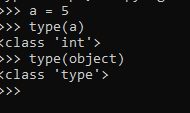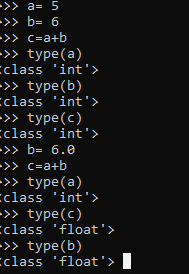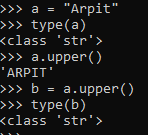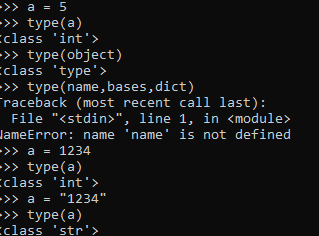Updated April 11, 2023
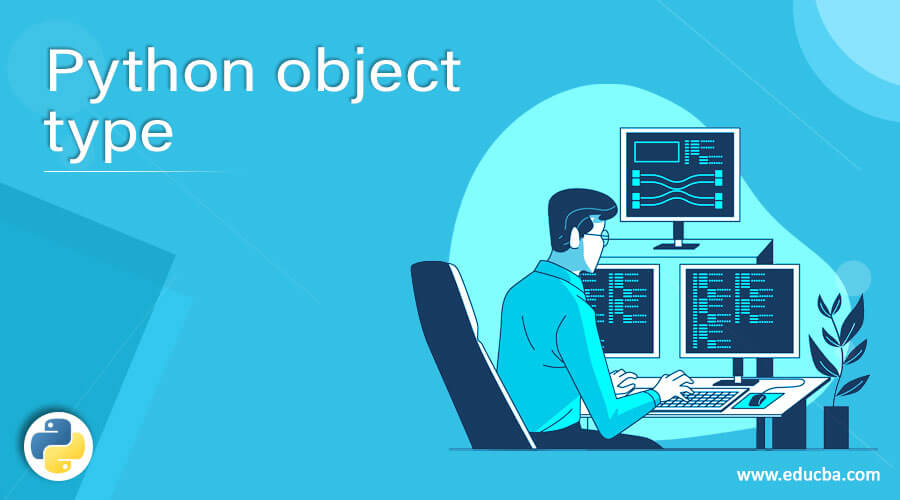
Introduction to Python Object Type
While processing in Python, Python Data generally takes the form of an object, either built-in, self-created or via external libraries. Python Object Type is necessary for programming as it makes the programs easier to write by defining some powerful tools for data Processing.
These object type in python are very well optimized and increases the level of performance for the code. They form the core of Programming Language. Python has a built-in method known as TYPE, and on passing the object, the type is returned.
Syntax
type(object)
>>> type(object)
<class 'type'>
>>> type(a)
<class 'int'>Screenshot:-
Type ( name , bases , dict)- Name :– It is the class Name .
- Bases :– Tuple from which the current class is derived.
- Dict :– Namespaces for the classes.
Working of Object Type
Object type uses the method Type(), which returns the type of the given object. There are two types of arguments that an Object can have:-
Single Argument and Three Argument.
type(object)
type(name , bases , dict)The return type returns the type of the object that the object holds.
Built-in Object Type with Examples
Python has some Built-in Objects types that are used in the programming approach. There are many built In Object Types in Python; we will check some of the Built-in Objects with Examples:-
Numbers (Class Int):-
This is of type integer.
Ex:-
>>> a = 5
>>> type(a)
<class 'int'>Even some operations over the number will give the object for that particular type of object.
On Changing the Type of any variable, the result type is also changed accordingly:-
For ex:-
>>> a= 5
>>> b= 6
>>> c=a+b
>>> type(a)
<class 'int'>
>>> type(b)
<class 'int'>
>>> type(c)
<class 'int'>This gives us an Integer. But suppose one of the value is changed, then the Type of the object will be changed.
>>> a= 5
>>> b= 6
>>> c=a+b
>>> type(a)
<class 'int'>
>>> type(b)
<class 'int'>
>>> type(c)
<class 'int'>Screenshot:-
String:-
This is of type String. String Basically is the ordered collection of other objects, which means that a Sequence is maintained for the items they are containing.
>>> a = "1234"
>>> type(a)
<class 'str'>We can also use various methods over the string Object Type and work over it. Strings being immutable in Python comes out with various String Methods that can be done without changing the Type of the Object.
Example:-
>>> a = "Arpit"
>>> type(a)
<class 'str'>
>>> a.upper()
'ARPIT'
>>> b = a.upper()
>>> type(b)
<class 'str'>List:-
This is of Type List. They are of the variable size ordered collections of objects. They are also a type of Sequence. They are mutable in nature. They are also ordered and changeable.
> a = ["A","b","c"]
>>> type(a)
<class 'list'>
>>>>>> type(a)
<class 'list'>Dictionary:-
This is of Dictionary Type. They are basically also called Mappings. Storing Objects by key and values associated with that particular Key. Being mutable in nature, they often have a variable size.
Example:-
>>> a = {‘name’ : 'anand' , 'age': '52'}
>>> type(a)
<class 'dict'>Tuple:-
This is of type Tuple. They are immutable in nature embedded in parenthesis. They are also sequenced, supporting all the sequence operations within. They are similar to the list but are immutable.
>>> a =(2,'anand','hello')
>>> type(a)
<class 'tuple'>Files:-
Files are the interface for our external Data on the computer. They are parameterized with the values, and we can do several operations over them Ex:- Write, Read, Open, Close.
These all are the built-in Operation in this object type. We need to provide the path or create the file and start the operation needed for it.
For Ex:-
F = open("path of File" , 'w') // w for write , r for read
f.write("message1")
f.write("message2")
f.close()Everything we do in Python Programming is a kind of Object. Having the type of Object gives the programmer a clear idea of the Object and Operation used.
We can check for the type of object with the Type name with Boolean values
For Example:-
>>> print(type([]) is list)
True
>>> print(type([]) is tuple)
FalseScreenshot:-
In a similar manner, we can check for a different type of objects.
>>> print(type({'name':'Arpit'}) is dict)
True
>>> print(type({'name':'Arpit'}) is tuple)
FalseConclusion
From the above article, we saw the use and the types of Python Objects. From various examples and classification, we tried to understand how everything in Python works is Objects and what are the various Object Types used.
We saw the use of Integer, String, Tuple, and other Built-in Objects in Python and saw the uses in the various programming aspects. Also, with the syntax and advantage, we checked the usage of all. So it is the basic and important aspect of any programming language.
Recommended Articles
This is a guide to Python object type. Here we discuss the uses and the types of Python Objects with various examples and classifications. You may also look at the following articles to learn more –
